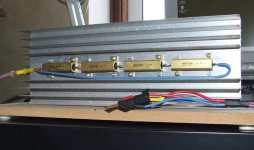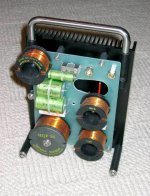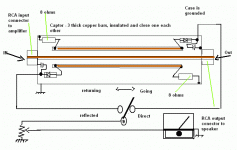A lightbulb is about the worst thing you could use to load an amplifier with. The resistance changes at about a 20:1 rate, being close to a dead short when cold.
Find some cheap resistors surplus, and wire them in series/parallel as needed to get whatever impedance you need.
Find some cheap resistors surplus, and wire them in series/parallel as needed to get whatever impedance you need.
http://www.skycraftsurplus.com/index.asp?PageAction=VIEWPROD&ProdID=896
Very cheap load resistor. Needs to be heat sinked.
Very cheap load resistor. Needs to be heat sinked.
The voice coil, inside oil, having its own magnetic element will be unbeatable
Only a real speaker, installed in a tuned duct housing will perform better as a load...because real load.
That coil is almost a real speaker..having normal inductances, resistances and capacitances....this way the reaction produced (EMF) is almost the same we have with speakers.... will loose the ressonances and this is something not good, as you will not measure, you will not observe the waveform that results of this normal sittuation.
Resistances are not a good load to amplifiers...as they are far away from the real condition the amplifier will works.... some resistances are so good, as resistances, that will have low inductance and low capacitance and this will produce a fause measurements of your amplifiers...the amplifier will measure much better than the reality..... fake measurements and wrong specifications will be produced.
I think that nothing can be better than a simple solution.... if you cannot use a real speaker with full volume under tests.
It is good to remember our friends Pinkmouse, that they cannot use the coil without the magnetic core, because it will burn in flames with 10 watts when normal power coil is used (100 IHF watts speaker coil... something alike 30 Watts continuous)
I feel myself very happy when i face those simple and perfect solutions.... something that simulators cannot make under real conditions as we cannot plug "that coil" in the computer communication's port.
regards,
Carlos
Only a real speaker, installed in a tuned duct housing will perform better as a load...because real load.
That coil is almost a real speaker..having normal inductances, resistances and capacitances....this way the reaction produced (EMF) is almost the same we have with speakers.... will loose the ressonances and this is something not good, as you will not measure, you will not observe the waveform that results of this normal sittuation.
Resistances are not a good load to amplifiers...as they are far away from the real condition the amplifier will works.... some resistances are so good, as resistances, that will have low inductance and low capacitance and this will produce a fause measurements of your amplifiers...the amplifier will measure much better than the reality..... fake measurements and wrong specifications will be produced.
I think that nothing can be better than a simple solution.... if you cannot use a real speaker with full volume under tests.
It is good to remember our friends Pinkmouse, that they cannot use the coil without the magnetic core, because it will burn in flames with 10 watts when normal power coil is used (100 IHF watts speaker coil... something alike 30 Watts continuous)
I feel myself very happy when i face those simple and perfect solutions.... something that simulators cannot make under real conditions as we cannot plug "that coil" in the computer communication's port.
regards,
Carlos
try to get some bit of reality into your numbers, PLEEEEASE!
.
I agree to Carlos point of view.
By the 107.33% level of pure non distortion!
Now there are different kinds of simple solutions for power resistor loads.
We have some low inductance specially made power resistors
made for 'pure resistance' tests loads
They have often the wire bi-filar wounded:
- that is for every wound one way they change direction
and wound one turn the opposite way
and when doing so, the inductances are more or less canceled .
They take out each other producing much lower inductance
although it is a wire wound resistor still.
Now normal standard power resistors
have all turns going same way, as in a coil.
This makes 'normal' Power Resistors have an inductance.
Even if this inductance is not to compare to a speaker or crossover inductance
.. it is step in the right direction of a real load.
So go for normal wire wound inductive power resistors in testing loads.
For power amplifiers output at least!
And the very good thing is
... they are the most low cost Power Resistors
we can find.
lineup
.
I agree to Carlos point of view.
By the 107.33% level of pure non distortion!
Now there are different kinds of simple solutions for power resistor loads.
We have some low inductance specially made power resistors
made for 'pure resistance' tests loads
They have often the wire bi-filar wounded:
- that is for every wound one way they change direction
and wound one turn the opposite way
and when doing so, the inductances are more or less canceled .
They take out each other producing much lower inductance
although it is a wire wound resistor still.
Now normal standard power resistors
have all turns going same way, as in a coil.
This makes 'normal' Power Resistors have an inductance.
Even if this inductance is not to compare to a speaker or crossover inductance
.. it is step in the right direction of a real load.
So go for normal wire wound inductive power resistors in testing loads.
For power amplifiers output at least!
And the very good thing is
... they are the most low cost Power Resistors
we can find.
lineup
http://www.stereophile.com/reference/60/
Very close to real life, other than they it does not produce sound, and costs much less to repair if any prototype amp dumps too much current on it.
One would need a large heatsink and 50-100W resistors at the right places.
Patrick
Very close to real life, other than they it does not produce sound, and costs much less to repair if any prototype amp dumps too much current on it.
One would need a large heatsink and 50-100W resistors at the right places.
Patrick
which is the whole point of using big simple resistors in the first place.
Of course it deosn't emulate a real speaker load, but when I first hook up my new whizzy-bang 100W amp and wish to check stability, temp rise, drift etc I an NOT going to hook it up to $1K worth of speakers!
That comes later when I know it is going to be a gentleman
Of course it deosn't emulate a real speaker load, but when I first hook up my new whizzy-bang 100W amp and wish to check stability, temp rise, drift etc I an NOT going to hook it up to $1K worth of speakers!
That comes later when I know it is going to be a gentleman
I wonder how one can really check stability without a reactive load. Of course one does not want to hook up to $1k speakers.
The circuit by John Atkinson costs about $50, so not much worst than resistors, but a lot closer to real speaker loads, IMHO.
Patrick
The circuit by John Atkinson costs about $50, so not much worst than resistors, but a lot closer to real speaker loads, IMHO.
Patrick
Attachments
EUVL said:I wonder how one can really check stability without a reactive load. Of course one does not want to hook up to $1k speakers.
The circuit by John Atkinson costs about $50, so not much worst than resistors, but a lot closer to real speaker loads, IMHO.
Patrick
A two stage process.
Use a crude R to check power, temperature, drift etc. THEN, when you are sure the amp is basically kosher, start adding parallel C's, series L's etc and finally a real speaker.
Hi
As a dummy test load I use two old 12" 8ohm speakers.
I have only damaged the cone once and I just glued it back together again and the speakers are back in service as a test load.
I do not think you can beat this as a first test load as it even produces nice sounds if everything goes well. I am currently using old goodmans speakers and I have a pair of B&W ready if needed in the future.
The only problems this sometimes causes is form my wife who thinks I should throw away some of this old gear!
Don
As a dummy test load I use two old 12" 8ohm speakers.
I have only damaged the cone once and I just glued it back together again and the speakers are back in service as a test load.
I do not think you can beat this as a first test load as it even produces nice sounds if everything goes well. I am currently using old goodmans speakers and I have a pair of B&W ready if needed in the future.
The only problems this sometimes causes is form my wife who thinks I should throw away some of this old gear!
Don
Yes... simple resistor can do the job to adjust bias, to observe heat and to check
VBE voltages and all stuff.
It is enougth and reasonable...low cost and very easy to install.
But if you intend to make detailed measurements you will need a more realistic load.
regards,
Carlos
VBE voltages and all stuff.
It is enougth and reasonable...low cost and very easy to install.
But if you intend to make detailed measurements you will need a more realistic load.
regards,
Carlos
I have a very very large heatsink with 8x Dale 250watt 4 ohm resistors mounted on it! I have it wired up so i can run stereo at 4 or 8 ohms.
I only use it for basic test's. after i have rebuilt a power amp or something i will run the amp up to clip and let is sit there for a good 15 minutes just to cook the amp in a bit and make sure there is no infant failure.
(BTW, even with a 500wpc@8 ohm amp running at clip, i have only barly got the heatsink warm to the touch!)
After that then i will let the amp cool and i have beat up old pair of Fischer speakers i use and run some music through the amp for several hours at various levels. Once i am satisified the amp will live without any funkyness killing the speakers, i will usually take it to my practice room and hook it up to an old pair of DLK speakers and crank it up for some Bass Practice. if it makes it through a few sessions of that. then i will consider moving it into the listening room and hooking it up to my main speakers.
Zc
I only use it for basic test's. after i have rebuilt a power amp or something i will run the amp up to clip and let is sit there for a good 15 minutes just to cook the amp in a bit and make sure there is no infant failure.
(BTW, even with a 500wpc@8 ohm amp running at clip, i have only barly got the heatsink warm to the touch!)
After that then i will let the amp cool and i have beat up old pair of Fischer speakers i use and run some music through the amp for several hours at various levels. Once i am satisified the amp will live without any funkyness killing the speakers, i will usually take it to my practice room and hook it up to an old pair of DLK speakers and crank it up for some Bass Practice. if it makes it through a few sessions of that. then i will consider moving it into the listening room and hooking it up to my main speakers.
Zc
which is the whole point of using big simple resistors in the first place.
Of course it deosn't emulate a real speaker load, but when I first hook up my new whizzy-bang 100W amp and wish to check stability, temp rise, drift etc I an NOT going to hook it up to $1K worth of speakers!
And of course it only emulates a 'typical" speaker not any particular one. I suppose you could modify to act fairly close to any particular speaker of your choice. Then I use one to emulate the speaker of MY choice. Bill, Bob and Mary each choose their own etc, etc. This makes it a bit tricky to describe results that any- & every-one can reproduce. The simple resistive 8-ohm and 4-ohm "standard" has the virtue of avoiding this ambiguity.
Also for developing an amplifier design there are a lot of things that need to be "taken care of" before you get to worrying about the peculiarities of speakers. In fact, a load that looks like a speaker could, in theory, lead one to develop a design that was optimum for one speaker but a mess with anything that deviates far from that.
The principle benefit of speaker-like load is probably to facilitate the development of an amplifier that is as indifferent as possible to different speaker characteristics.
Resistor, in special de low inductance ones, special units
Are loads that will be perceived as something perfect to the amplifier...the amplifier will "see" a nice load...not a real complex load that we have using strange cables, crazy crossovers and reactive speakers.
If you like to check those crazy things, produce a reflectometer...the same used to Radio Frequency, and check the return patch...adjust zero the going signal to full pointer deflection and observe what will return.....the return is a visual information about the mismatch you have.
Use full power and high frequencies inside the audible range.
Those copper bars need to be in close contact, and insulated, they will capture the magnetic field that will be formed around those copper bars....this will be rectified and a capacitor to audio frequencies will help to filter (223).... the switch will select the going and returning signals (they appear simultaneously, but to allow you to use only one microamperimeter, we have installed the switch)
Those mismatch happens related phase.... and you can understand as some "returning and lost energy)
Install a resistor and you will see that this return is minimum.... this will means that the resistance is an excelent load....but do not produce sound, and it is a fake load to the amplifier that will behave very different when connected to real loads....the amplifier can even oscilate with a speaker and not oscilate with a resistance..
When testing using a real speaker...you will see the crazy mismatch, and this will be different depending from the frequency..of course.
Real life sound reproduction have to face the "damn piston"...the speaker....moving both directions...having inductance, resistance and capacitance... the weekest part of the entire audio chain.... the final result will depend of the speaker, as it will distort more than the amplifier and the audio source.
Good matched amplifiers sounds better than the ones not so good matched....of course Tophologie plays a lot about that
We have a lot of guys reducing amplifier distortion to minimum...when the speaker will create much more than that....unfortunattelly this is something alike to have poluted water to drink...and to reduce it's polution, people are washing the glasses many times...to reduce polution.
regards,
Carlos
Are loads that will be perceived as something perfect to the amplifier...the amplifier will "see" a nice load...not a real complex load that we have using strange cables, crazy crossovers and reactive speakers.
If you like to check those crazy things, produce a reflectometer...the same used to Radio Frequency, and check the return patch...adjust zero the going signal to full pointer deflection and observe what will return.....the return is a visual information about the mismatch you have.
Use full power and high frequencies inside the audible range.
Those copper bars need to be in close contact, and insulated, they will capture the magnetic field that will be formed around those copper bars....this will be rectified and a capacitor to audio frequencies will help to filter (223).... the switch will select the going and returning signals (they appear simultaneously, but to allow you to use only one microamperimeter, we have installed the switch)
Those mismatch happens related phase.... and you can understand as some "returning and lost energy)
Install a resistor and you will see that this return is minimum.... this will means that the resistance is an excelent load....but do not produce sound, and it is a fake load to the amplifier that will behave very different when connected to real loads....the amplifier can even oscilate with a speaker and not oscilate with a resistance..
When testing using a real speaker...you will see the crazy mismatch, and this will be different depending from the frequency..of course.
Real life sound reproduction have to face the "damn piston"...the speaker....moving both directions...having inductance, resistance and capacitance... the weekest part of the entire audio chain.... the final result will depend of the speaker, as it will distort more than the amplifier and the audio source.
Good matched amplifiers sounds better than the ones not so good matched....of course Tophologie plays a lot about that
We have a lot of guys reducing amplifier distortion to minimum...when the speaker will create much more than that....unfortunattelly this is something alike to have poluted water to drink...and to reduce it's polution, people are washing the glasses many times...to reduce polution.
regards,
Carlos
Attachments
- Status
- This old topic is closed. If you want to reopen this topic, contact a moderator using the "Report Post" button.
- Home
- Amplifiers
- Solid State
- What do you use for a simple cheap load?


